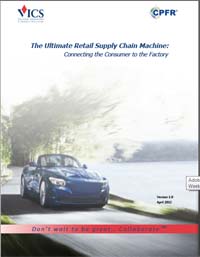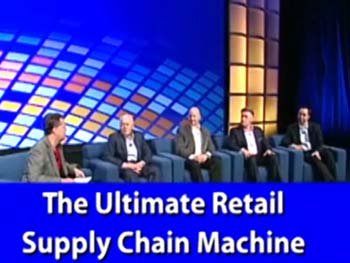|
Are we finally real close to getting supply chain just right in consumer goods to retail sector?
This is an important question for not only CG manufacturers and retailers, but really for most of our supply chains, as virtually every company is connected to that value chain in some way, and so many of our broader supply chain themes and technologies have their roots in the consumer goods to retail sector.
There obviously has been significant improvement in almost every area of this important supply chain area over many years. And yet, the same basic set of issues (too much inventory, not enough collaboration, still too many stockouts, etc.) have seemed to persist.
Along the way, the industry has seen many initiatives: Efficient Consumer Response (ECR), Quick Response (sort of the ECR equivalent for the soft goods sector), Continuous Replenishment, Collaborative Planning, Forecasting and Replenishment (CPFR), RFID… I have probably missed one or two.
I think I would be far from the only one who would say while each of these industry programs has delivered benefits and moved the ball down the field, there was always the feeling that the potential had not quite been truly grasped. The same problems seemed to remain. In fact, if you look at the language from the documents describing these initiatives, often from the VICS organization now run by my friend Joe Andraski, you will see highly similar language over many years describing the industry challenges and opportunities from the latest program.
Why is this? Well, I don’t have room here today to fully ponder that (would welcome your thoughts) other than to say change almost always takes longer than we expect, and that at the core of many of these initiatives was really the need for true collaboration, a hurdle the industry has never really surmounted, and maybe never will.
But the answer may be to replace collaboration with mathematics. Not completely, in truth, but to a significant degree.
I first started hearing Procter & Gamble talk about the “consumer-driven” supply chain and “building the supply chain from the shelf-back” almost a decade ago. From that thinking came AMR Research’s (now part of Gartner) “Demand-Driven Supply Networks” (DDSN) paradigm in roughly the middle part of the last decade, and the industry has been moving, if slowly, down this path ever since.
In May, VICS delivered perhaps its most important initiative/document ever, what it calls a guideline on "The Ultimate Retail Supply Chain Machine: Connecting the Consumer to the Factory."
I am greatly, greatly summarizing here, but one core of this is taking traditional concepts and tools relative to Distribution Requirement Planning (DRP), which really were designed for replenishment to distribution centers, and moving that all the way to the store itself. Let actual consumer demand at the store truly drive the rest of the supply chain, all the way to the manufacturer’s factories.
Hmmm… letting true consumer demand drive the supply chain. Who would have guessed?
I’ve used this many times before, but one of my favorite supply chain quips was going around at the start of my career 20 years ago, and that was supply chain will drive us to the point that when a sweater gets sold in Peoria, a sheep is shorn somewhat in New Zealand. The two key points: (1) Sell one, ship one; and (2) Everything should be connected to the shelf.
Well, we certainly aren’t there yet, though Spain’s Zara on the specialty retail side is pretty close. But this new “shelf back” thinking may get most everyone else there before long.
So, you may ask, why has it taking us this long. First, you just can’t rush the soup. Things (people, process and technology) just take time to evolve. Rarely are there leapfrog changes.
 Second, this was a tough technology challenge. Andre Martin, actually the inventor of the original DRP concept and now part of RedPrairie’s Flowcasting group, told me not long ago that this approach involves forecasting every product for every story every day. That was a big nut to crack, but software and hardware improvements have now made it not just possible but very real. With that done, inherently more accurately because you are closer to demand, the benefits can flow back up the supply chain, and further automate replenishment processes. Second, this was a tough technology challenge. Andre Martin, actually the inventor of the original DRP concept and now part of RedPrairie’s Flowcasting group, told me not long ago that this approach involves forecasting every product for every story every day. That was a big nut to crack, but software and hardware improvements have now made it not just possible but very real. With that done, inherently more accurately because you are closer to demand, the benefits can flow back up the supply chain, and further automate replenishment processes.
I also had the chance to interview Andraski, Leroy Allen of Lowe’s, Fred Baumann of JDA Software, and Al Jankauskas of Kraft, all very involved along with Andre Martin and many others in creating the VICS guideline, about the importance of this shelf-back thinking. By the way, the VICS organization has graciously made the document available to SCDigest readers. You can find it here: The Ultimate Retail Supply Chain Machine: Connecting the Consumer to the Factory.
That group interview in fact brought up a second major theme of this change, in addition to the store-level DRP, and that is that the retailers are, really for the first time, starting to use the sort of “time-phased” order forecasting approaches that have been in commonplace for years on the manufacturing side.
This is a seminal shift. Lowes has been one of the most aggressive in the retail industry in adopting this time-phased approach, and I happen to know it is a critical plank in the company’s overall aggressive drive to create an integrated planning and execution environment (more on that someday soon).
During the interview, Allen told me that this new time-phased approach “provides the forward visibility that you need, and helps you maximize financial results.”
Previously, JDA’s Baumann had started the discussion on this topic, noting that the group producing the guideline agreed that retail planning horizons had typically been too short, and that retailers are too often focused on “just that next order.” As these retail planning horizons are extended and a time-phased view of the world is adopted, this naturally then leads to real use of Sales & Operations, or whatever a retailer might call the process, something that again has been uncommon in retailers. Lowes, as an aside, has also been one of the early and effective practitioners of retail S&OP.
Finally, I will just note that this store level DRP approach, combined with a new strategy relative to leveling manufacturing schedules with great success at Kraft, has the opportunity to get something fairly close to supply chain perfection. Ok, I am exaggerating a bit, but not by as much as you might think. More on this soon.
You can find the VICS guideline video interview here.


We can always use more collaboration, and we will get some of that coming out of this, I believe. But that is because to connect the shelf to the factory, better supply chain math is going to help lead us there.
Do you see this thinking as leading to an important change in the consumer goods to retail supply chain? Why or why not? Let us know your thoughts at the Feedback section below.
|